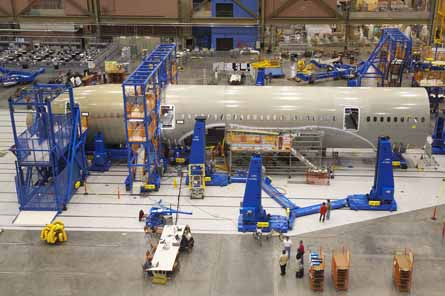Boeing has revealed new details of its initial production plans for the 787, as the first test airframe begins final assembly in Everett, Washington.
Production is based on a "pulsed" line that could be changed to a moving line like those of the 737/777 "if we want to", says Steve Westby, 787 vice-president of manufacturing and quality. Following initial preparation of sections brought in by 747 Dreamlifter in a pre-integration bay, the sections are assembled in position one of a three-position line. A fourth position is also allocated for future production growth. "By line number 100 we will be at a six-day flow, though our stretch target is three days," says Westby.

Flight International has also learned Boeing is adopting a "ZA" nomenclature for the initial Rolls-Royce Trent 1000-powered 787-8 airframe "ZA001", which is due to fly in August. Next to be assembled will be the static test airframe, followed by ZA002, the second R-R test aircraft. The fourth will be the fatigue test airframe, while the following six will include the remaining two R-R test aircraft, the initial production versions for launch customer All Nippon Airways and the two General Electric GEnx-powered test aircraft, ZA005 and 006.
The test aircraft will be refurbished in 2008 for delivery to ANA and Northwest Airlines, while the seventh aircraft, and the first to be handed over to ANA next year, will be the first at the production-standard weight. "It looks like we're coming in just under the wire on weight," says Scott Stode, 787 vice -president of airplane definition and production. "We're not over, and just under - which is good," he adds.
Boeing is also yet to decide whether or not to take the full-scale static test airframe to destruction as the final part of its structural testing beyond design limit loads. Tests have also been under way on a two-thirds scale wingbox test unit, and results have been positive, according to Strode. "We're asking what will we gain, if anything, by taking the wing all the way to breaking point," he says, adding that one consideration is the large cost associated with cleaning up the fibrous contaminents that will result.
Related article:
Boeing readies first 787's systems
Source: Flight International























